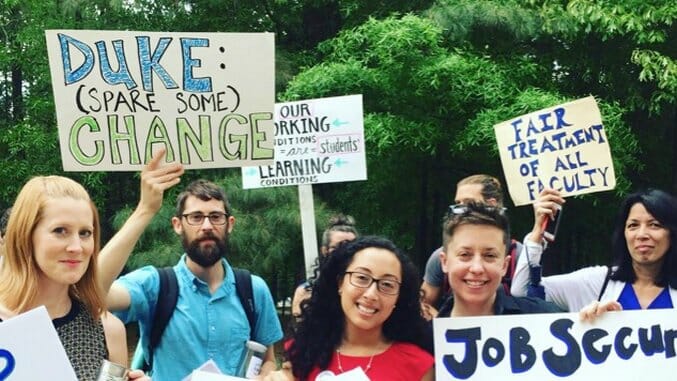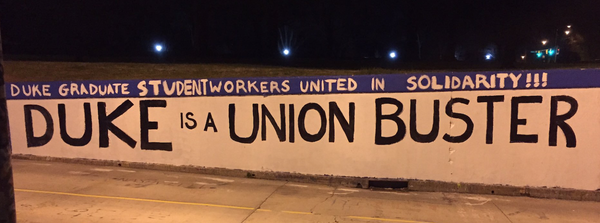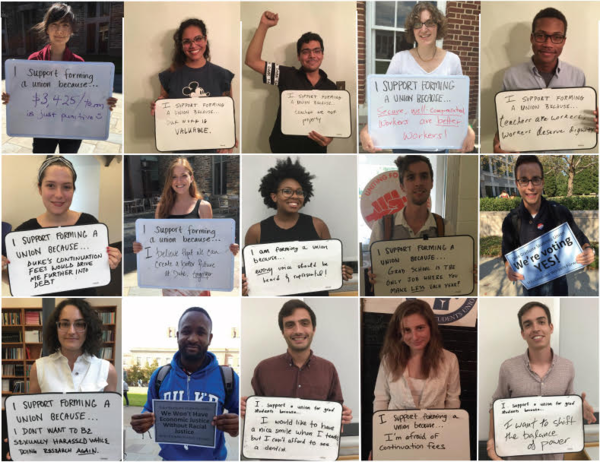Graduate Worker and Faculty Unions Are Taking on Duke’s Administration
Photo by Sara D. Davis Politics Features Duke University
This April, Duke University celebrated a $3.25 billion addition to its already generous endowment. By that time, the administration had been in bargaining for nine months with the Duke Faculty Union, which represents contingent (adjunct/part-time/non-regular full-time) faculty. Instead of directly addressing low wages that have some full-time contingent faculty eligible for food stamps and others working multiple part time jobs to make ends meet, Duke’s initial response to bargaining was to offer workers contracts largely the same as, or worse than, the status quo. A few months earlier, as graduate workers fought for a seat at the bargaining table in an effort to unionize, Duke spent millions of dollars on union-busting Proskauer Rose lawyers to disenfranchise hundreds of graduate workers. These costly legal efforts ultimately challenged enough ballots that the union election results were inconclusive. The university made its priorities clear: despite its immense financial resources, the administration would work against non-regular faculty and graduate workers every step of the way.
Employers are already powerful in the South, buffered by right-to-work laws that the political right is now seeking to deploy nationally. Right-to-work and other weak labor protections in North Carolina mean that less than 2% of workers belong to a union. And since all of the state’s public employees are legally barred from collective bargaining, there is little history of faculty or graduate worker unions at the state’s public universities. This unfriendly labor climate, coupled with the modern corporatization of the university, hurts workers. Duke, like many large universities, increasingly relies upon low-wage faculty on short-term contracts and no-contract graduate students to do the bulk of the teaching and much of the research. This replicates an established corporate cost-saving strategy of replacing secure, full-time positions with temporary and part-time work.
The Faculty Union Campaign
As ranks of adjunct faculty grow across the country, so do reports of low pay and poor working conditions. Duke is no exception: while outgoing university president Dick Brodhead took home well over $1 million last year and assistant professors receive on average $125,000 per year, the average adjunct is paid an annual salary of around $30,000. Contracts are typically year-to-year, classes are subject to cancellation until the last minute, health benefits are only occasionally offered, and pensions are virtually nonexistent. Contingent faculty are critical to the university’s operations—at Duke they teach over 800 courses, perform crucial administrative tasks for their departments, publish original research, mentor students, and manage centers. Some are veteran teachers with full-time course loads who are forced to take on extra work to support their families. Yet at being told that some members of contingent faculty still qualify for food stamps, Duke’s administration played the part of the wounded party and stormed out of negotiations.
When the faculty unionization campaign began in spring 2015, Duke argued that faculty needs were better met by direct, one-on-one engagement with the administration. According to an organizer, “It was like a union-busting kit. There was no human face on it.” Operating on standard divide-and-conquer tactics, Duke pitted department against department and full-timers against part-timers. MJ Sharp, an instructor in the Center for Documentary Studies, remembers, “They tried to ‘fix’ everything by bettering several people’s situations in order to try to defuse the union momentum. It was such a clear indication that unionizing was the only thing that could get the administration’s attention.” Duke’s 300-odd contingent faculty recognized that bargaining individually was an ineffective strategy and voted 6 to 1 in favor of their union.
The Graduate Workers’ Campaign
Duke’s graduate students faced a different set of challenges. Last August, the NLRB recognized the right of graduate student workers to unionize at private universities across the country. Support for unionization built quickly on campus, as graduate workers across the university shared ideas for improving their working conditions. Graduate students are frequent victims of sexual assault, harassment, and discrimination, and demands for formal grievance procedures were loudly voiced during the campaign at Duke and on other unionizing campuses. A 2015 report on sexual assault and misconduct shows that nearly half of graduate students report sexual harassment, and over one in ten report non-consensual sexual violence. Duke has a set of policies and procedures for graduate student workers that are far more burdensome than they are for undergraduates. Financial insecurity is a real issue for graduate students, and Duke’s unilateral policy changes mean irregular and constantly changing paychecks. Graduate students, well into adulthood, lack any meaningful parental leave or childcare options.
The Duke Graduate Students’ Union (DGSU) filed for an union election in early November, about the time Trump won the presidency and the right wing retained both Congressional houses. Graduate students at Duke are a workforce about 6 times larger than contingent faculty, so unionized graduate workers are a larger threat to the University’s financial bottom line. Accordingly, Duke spent around a million dollars on Proskauer Rose, a New York City firm famed for its union-busting, to hold up its graduate students in court for a few extra weeks.
During this time, Proskauer Rose—the same firm to argue and lose the Columbia case that set the stage for Duke’s election—tried to relitigate the original NLRB decision. Proskauer Rose has emerged as a common thread in graduate worker unionization efforts—despite losing nearly every argument, their costly hearings buy employers time to operate in the background against union campaigns. In Duke’s case, the administration used the extra time to spread threats and misinformation widely across campus, breaking its obligation to remain neutral and uninvolved in the unionization of its employees. When the election finally came around, the inconclusive results made clear that their legal and psychological fragmentation of graduate students had been effective.
Steps Forward
After the election, DGSU decided to affiliate with Workers United/SEIU and form a minority union. Graduate workers used direct action to regain access to university resources and continue to build membership on campus. Alongside other graduate unions, DGSU is developing a national campaign to bring attention to sexual assault, harassment, and discrimination on university campuses. Trump’s NLRB is likely to reverse the decision that precipitated the union election, so graduate students seeking to improve their working conditions at other universities seem likely to follow the minority union model.
The Duke Faculty Union remains in negotiations. Early concessions by the administration to the union offered compensation changes so trivial that the faculty prepared for a strike. Once the union published an open letter to the Provost and began spreading the word on social and traditional media, the administration began to move; after considerable effort the union looks to achieve some meaningful, if incremental, contract improvements. The largest improvements come for the union’s lowest-paid members. For months, their colleagues rallied to their cause, holding public demonstrations and distributing information to make sure that standards would be raised for the union’s least well-off members. Under the anticipated contract, every member of the bargaining unit will see a raise, and the pay structure will be linked to years of service rather than arbitrary departmental decisions. In spite of obstacles, faculty members are finding strength as a union, and look to ratify the new contract before the fall semester.
Duke’s $7 billion endowment ranks it among the 20 richest private universities in the world. The public knows little about the sources of Duke’s fortune, or—besides the stream of new construction projects and jaw-dropping executive salaries—how its administration opts to spend it. What speaks volumes is Duke’s persistence in paying so many of its workers near-poverty wages and, perhaps more tellingly, the choice to pay millions of dollars to lawyers simply to deny them any meaningful voice in their working conditions. Low-paid researchers and teachers fulfill the basic functions of a university, and are fighting a battle against millionaire executives and their donors—a struggle that brings the rabid corporatization of U.S. private universities into sharp relief. The strengths and possibilities of higher education unions are quickly becoming clear as the faculty and graduate workers achieve their respective gains, but the fight for a more just and transparent university will not be easily resolved.
Mike is a PhD student and research assistant at Duke’s Sanford School of Public Policy. Jessica is a PhD student and teaching assistant in Duke’s Literature program. Keep up with the Duke Graduate Students’ Union @dukegradunion and Duke Faculty Union @teachdukeunion on Twitter.

